Decarbonizing the Cold Chain: Long-Haul Refrigerated Deliveries with On-Board Photovoltaic Energy Integration
Abstract
:1. Introduction
2. Modeling the Long-Haul Refrigerated Delivery with PV Integration
2.1. The Long-Haul PV Refrigerated Delivery Graph
2.2. Optimal PV System Size: The Constraint Programming Model
operation_costs = charge_cost + maintenance_cost − fuel_savings
3. Results
3.1. Basic Scenario
3.1.1. Sensitivity Analysis on Component Costs
3.1.2. Worst Case Analysis
3.2. Sensitivity Analysis on Delivery Tour Features
3.2.1. From Chilled to Frozen Products: Impact of the Internal Temperature
3.2.2. Moving toward Different Climate Zones
3.2.3. Introducing a Complementary Business for the Return Journey
4. Discussion
5. Conclusions
Author Contributions
Funding
Institutional Review Board Statement
Informed Consent Statement
Data Availability Statement
Conflicts of Interest
References
- IIR-International Institute of Refrigeration. Europe Dominated the Global Frozen Food Market in 2020. Available online: https://iifiir.org/en/news/europe-dominated-the-global-frozen-food-market-in-2020 (accessed on 1 March 2021).
- UWT. COVID-19 Effects on Refrigerated Transport Demand. 2020. Available online: https://unitedworldtransportation.com/covid-19-effects-on-refrigerated-transport-demand/ (accessed on 1 March 2021).
- EEA. Final Energy Consumption by Sector and Fuel in Europe. 2020. Available online: https://www.eea.europa.eu/data-and-maps/indicators/final-energy-consumption-by-sector-10/assessment (accessed on 1 March 2021).
- EEA. Greenhouse Gas Emissions from Transport in Europe. 2019. Available online: https://www.eea.europa.eu/data-and-maps/indicators/transport-emissions-of-greenhouse-gases/transport-emissions-of-greenhouse-gases-12 (accessed on 1 March 2021).
- James, S.J.; Swain, M.J.; Brown, T.; Evans, J.A.; Tassou, S.A.; Ge, Y.T. Improving the Energy Efficiency of Food Refrigeration Operations; Institute of Refrigeration: London, UK, 2009. [Google Scholar]
- Tassou, S.; De-Lille, G.; Ge, Y. Food Transport Refrigeration—Approaches to Reduce Energy Consumption and Environmental Impacts of Road Transport. Appl. Therm. Eng. 2009, 29, 1467–1477. [Google Scholar] [CrossRef] [Green Version]
- Bagheri, F.; Fayazbakhsh, M.A.; Bahrami, M. Real-time performance evaluation and potential GHG reduction in refrigerated trailers. Int. J. Refrig. 2017, 73, 24–38. [Google Scholar] [CrossRef]
- Meneghetti, A.; Dal Magro, F.; Simeoni, P. Fostering Renewables into the Cold Chain: How Photovoltaics Affect Design and Performance of Refrigerated Automated Warehouses. Energies 2018, 11, 1029. [Google Scholar] [CrossRef] [Green Version]
- Laurischkat, K.; Jandt, D. Techno-economic analysis of sustainable mobility and energy solutions consisting of electric vehicles, photovoltaic systems and battery storages. J. Clean. Prod. 2018, 179, 642–661. [Google Scholar] [CrossRef]
- Buonomano, A.; Calise, F.; Cappiello, F.; Palombo, A.; Vicidomini, M. Dynamic analysis of the integration of electric vehicles in efficient buildings fed by renewables. Appl. Energy 2019, 245, 31–50. [Google Scholar] [CrossRef]
- Ghazvini, A.M.; Olamaei, J. Optimal sizing of autonomous hybrid PV system with considerations for V2G parking lot as controllable load based on a heuristic optimization algorithm. Sol. Energy 2019, 184, 30–39. [Google Scholar] [CrossRef]
- Turan, M.T.; Ates, Y.; Erdinc, O.; Gokalp, E.; Catalão, J.P. Effect of electric vehicle parking lots equipped with roof mounted photovoltaic panels on the distribution network. Int. J. Electr. Power Energy Syst. 2019, 109, 283–289. [Google Scholar] [CrossRef]
- Calise, F.; Cappiello, F.L.; Cartenì, A.; D’Accadia, M.D.; Vicidomini, M. A novel paradigm for a sustainable mobility based on electric vehicles, photovoltaic panels and electric energy storage systems: Case studies for Naples and Salerno (Italy). Renew. Sustain. Energy Rev. 2019, 111, 97–114. [Google Scholar] [CrossRef]
- Cartenì, A.; Henke, I.; Molitierno, C.; Di Francesco, L. Strong Sustainability in Public Transport Policies: An e-Mobility Bus Fleet Application in Sorrento Peninsula (Italy). Sustainability 2020, 12, 7033. [Google Scholar] [CrossRef]
- Good, C.; Shepero, M.; Munkhammar, J.; Boström, T. Scenario-based modelling of the potential for solar energy charging of electric vehicles in two Scandinavian cities. Energy 2019, 168, 111–125. [Google Scholar] [CrossRef]
- Kobashi, T.; Yoshida, T.; Yamagata, Y.; Naito, K.; Pfenninger, S.; Say, K.; Takeda, Y.; Ahl, A.; Yarime, M.; Hara, K. On the potential of “Photovoltaics + Electric vehicles” for deep decarbonization of Kyoto’s power systems: Techno-economic-social considerations. Appl. Energy 2020, 275, 115419. [Google Scholar] [CrossRef]
- Hoarau, Q.; Perez, Y. Interactions between electric mobility and photovoltaic generation: A review. Renew. Sustain. Energy Rev. 2018, 94, 510–522. [Google Scholar] [CrossRef] [Green Version]
- D’Adamo, I.; Falcone, P.M.; Gastaldi, M.; Morone, P. The economic viability of photovoltaic systems in public buildings: Evidence from Italy. Energy 2020, 207, 118316. [Google Scholar] [CrossRef]
- Motahhir, S.; El Hammoumi, A.; El Ghzizal, A. The most used MPPT algorithms: Review and the suitable low-cost embedded board for each algorithm. J. Clean. Prod. 2020, 246, 118983. [Google Scholar] [CrossRef]
- El Hammoumi, A.; Motahhir, S.; Chalh, A.; El Ghzizal, A.; Derouich, A. Real-time virtual instrumentation of Arduino and LabVIEW based PV panel characteristics. IOP Conf. Ser. Earth Environ. Sci. 2018, 161, 1–11. [Google Scholar] [CrossRef]
- El Hammoumi, A.; Motahhir, S.; Chalh, A.; El Ghzizal, A.; Derouich, A. Low-cost virtual instrumentation of PV panel characteristics using Excel and Arduino in comparison with traditional instrumentation. Renew. Wind Water Sol. 2018, 5, 3. [Google Scholar] [CrossRef]
- Chalh, A.; El Hammoumi, A.; Motahhir, S.; El Ghzizal, A.; Subramaniam, U.; Derouich, A. Trusted Simulation Using Proteus Model for a PV System: Test Case of an Improved HC MPPT Algorithm. Energies 2020, 13, 1943. [Google Scholar] [CrossRef] [Green Version]
- Chtita, S.; Derouich, A.; El Ghzizal, A.; Motahhir, S. An improved control strategy for charging solar batteries in off-grid photovoltaic systems. Sol. Energy 2021, 220, 927–941. [Google Scholar] [CrossRef]
- Abdelhamid, M.; Pilla, S.; Singh, R.; Haque, I.; Filipi, Z. A comprehensive optimized model for on-board solar photovoltaic system for plug-in electric vehicles: Energy and economic impacts. Int. J. Energy Res. 2016, 40, 1489–1508. [Google Scholar] [CrossRef]
- Fathabadi, H. Novel battery/photovoltaic hybrid power source for plug-in hybrid electric vehicles. Sol. Energy 2018, 159, 243–250. [Google Scholar] [CrossRef]
- Bhargav, P.; Kaushik, S. Real-Time Energy Management Scheme for Dual Converter-Based Hybrid Solar/Battery/Ultra-Capacitor Vehicular System. Lect. Notes Electr. Eng. 2019, 556, 369–385. [Google Scholar] [CrossRef]
- Ifaei, P.; Khiabani, H.; Piran, J.; Yoo, C. Techno-econo-environmental feasibility of retrofitting urban transportation system with optimal solar panels for climate change mitigation–A case study. J. Clean. Prod. 2020, 251, 119639. [Google Scholar] [CrossRef]
- Oh, M.; Kim, S.-M.; Park, H.-D. Estimation of photovoltaic potential of solar bus in an urban area: Case study in Gwanak, Seoul, Korea. Renew. Energy 2020, 160, 1335–1348. [Google Scholar] [CrossRef]
- Bahaj, A. World’s first solar powered transport refrigeration system. Renew. Energy 1998, 15, 572–576. [Google Scholar] [CrossRef]
- Bahaj, A.S. Photovoltaic power for refrigeration of transported perishable goods. In Proceedings of the Conference Record of the Twenty-Eighth IEEE Photovoltaic Specialists Conference-2000 (Cat. No.00CH37036), Anchorage, AK, USA, 15–22 September 2000; Volume 2000, pp. 1563–1566. [Google Scholar] [CrossRef]
- Bahaj, A.S.; James, P.A.B. Economics of solar powered refrigeration transport applications. In Proceedings of the Conference Record of the Twenty-Ninth IEEE Photovoltaic Specialists Conference, New Orleans, LA, USA, 19–24 May 2002; pp. 1561–1564. [Google Scholar]
- Kumar, S.; Bharj, R. Energy consumption of solar hybrid 48V operated mini mobile cold storage. IOP Conf. Ser. Mater. Sci. Eng. 2018, 455, 012049. [Google Scholar] [CrossRef]
- Buitendach, H.P.C.; Jiya, I.N.; Gouws, R. Solar powered peltier cooling storage for vaccines in rural areas. Indones. J. Electr. Eng. Comput. Sci. 2020, 17, 36–46. [Google Scholar] [CrossRef]
- Meneghetti, A.; Dal Magro, F.; Romagnoli, A. Renewable energy penetration in food delivery: Coupling photovoltaics with transport refrigerated units. Energy 2021, 232, 120994. [Google Scholar] [CrossRef]
- Meneghetti, A.; Ceschia, S. Energy-efficient frozen food transports: The Refrigerated Routing Problem. Int. J. Prod. Res. 2019, 58, 4164–4181. [Google Scholar] [CrossRef]
- Ceschia, S.; Di Gaspero, L.; Meneghetti, A. Extending and Solving the Refrigerated Routing Problem. Energies 2020, 13, 6214. [Google Scholar] [CrossRef]
- Rossi, F.; van Beek, P.; Walsh, T. Handbook of Constraint Programming; Elsevier Science Inc.: New York, NY, USA, 2006. [Google Scholar]
- Huld, T.; Amillo, A.M.G. Estimating PV Module Performance over Large Geographical Regions: The Role of Irradiance, Air Temperature, Wind Speed and Solar Spectrum. Energies 2015, 8, 5159–5181. [Google Scholar] [CrossRef] [Green Version]
- Faiman, D. Assessing the outdoor operating temperature of photovoltaic modules. Prog. Photovolt. Res. Appl. 2008, 16, 307–315. [Google Scholar] [CrossRef]
- Barth, M.; Scora, G.; Younglove, T. Modal Emissions Model for Heavy-Duty Diesel Vehicles. Transp. Res. Rec. J. Transp. Res. Board 2004, 1880, 10–20. [Google Scholar] [CrossRef] [Green Version]
- Franceschetti, A.; Demir, E.; Honhon, D.; Van Woensel, T.; Laporte, G.; Stobbe, M. A metaheuristic for the time-dependent pollution-routing problem. Eur. J. Oper. Res. 2017, 259, 972–991. [Google Scholar] [CrossRef] [Green Version]
- Huld, T.; Müller, R.; Gambardella, A. A new solar radiation database for estimating PV performance in Europe and Africa. Sol. Energy 2012, 86, 1803–1815. [Google Scholar] [CrossRef]
- Nethercote, N.; Stuckey, P.J.; Becket, R.; Brand, S.; Duck, G.J.; Tack, G. MiniZinc: Towards a standard CP modelling language. In Lecture Notes in Computer Science; Springer: Berlin, Germany, 2007; Volume 4741, pp. 529–543. [Google Scholar] [CrossRef]
- Otten, M.; Hoen, M.; den Boer, E. Electrical Trailer Cooling during Rest Periods; CE Delft: Delft, The Netherlands, 2015; p. 51. [Google Scholar]
- Tsiropoulos, I.; Tarvydas, D.; Lebedeva, N. Li-Ion Batteries for Mobility and Stationary Storage Applications; Publications Office of the European Union: Luxembourg, 2018. [Google Scholar] [CrossRef]
- IRENA. The Power to Change: Solar and Wind Cost Reduction Potential to 2025. Available online: https://www.irena.org/-/media/Files/IRENA/Agency/Publication/2016/IRENA_Power_to_Change_2016.pdf (accessed on 1 March 2021).
- Feldman, D.; Zwerling, M.; Margolis, R. Q2/Q3 2019 Solar Industry Update. Natl. Renew. Energy Lab. 2019, 1–48. [Google Scholar] [CrossRef]
- EEA. CO2 Emission Intensity of Electricity Generation. 2017. Available online: https://www.eea.europa.eu/data-and-maps/data/co2-intensity-of-electricity-generation (accessed on 1 March 2021).



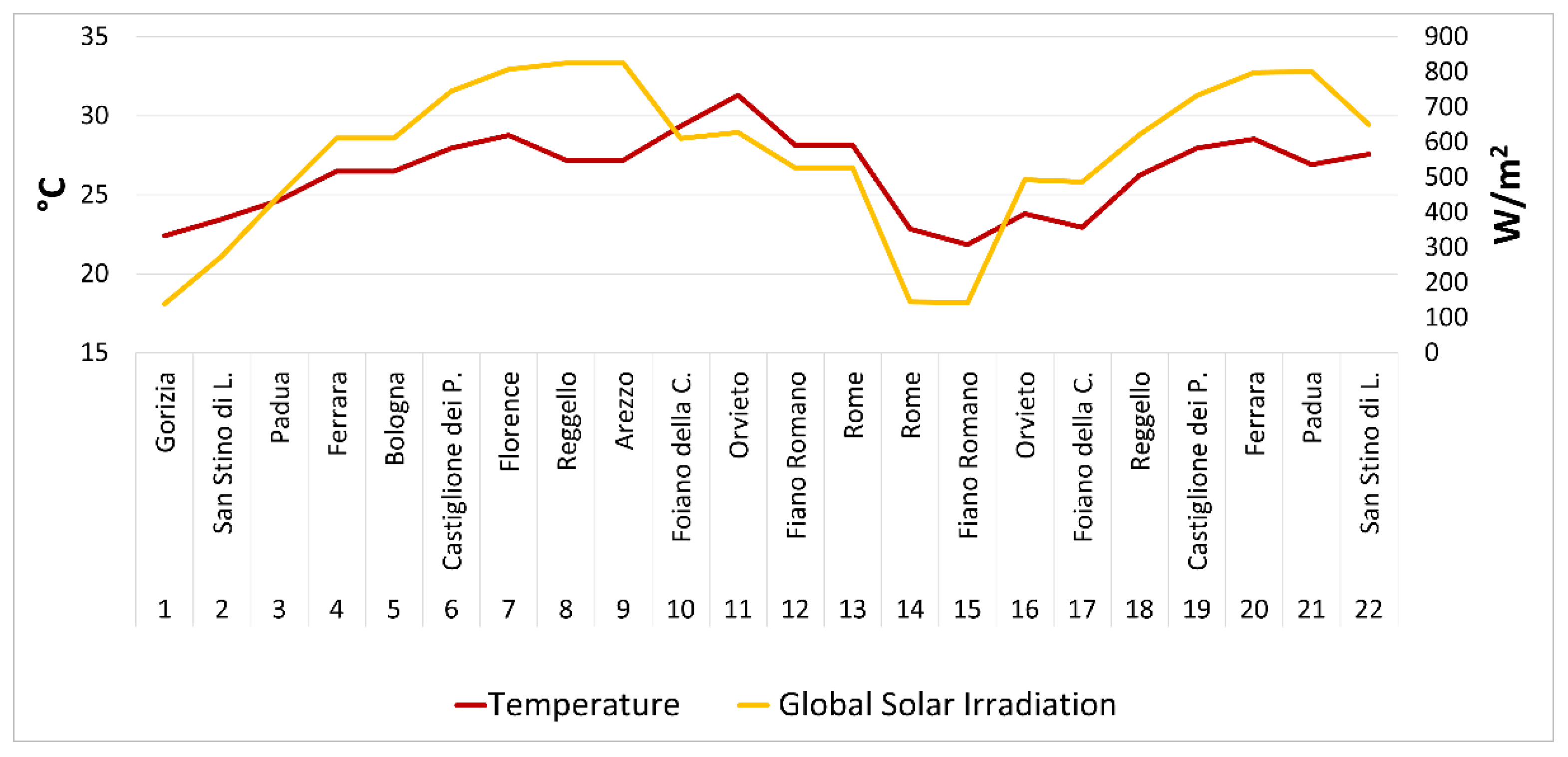
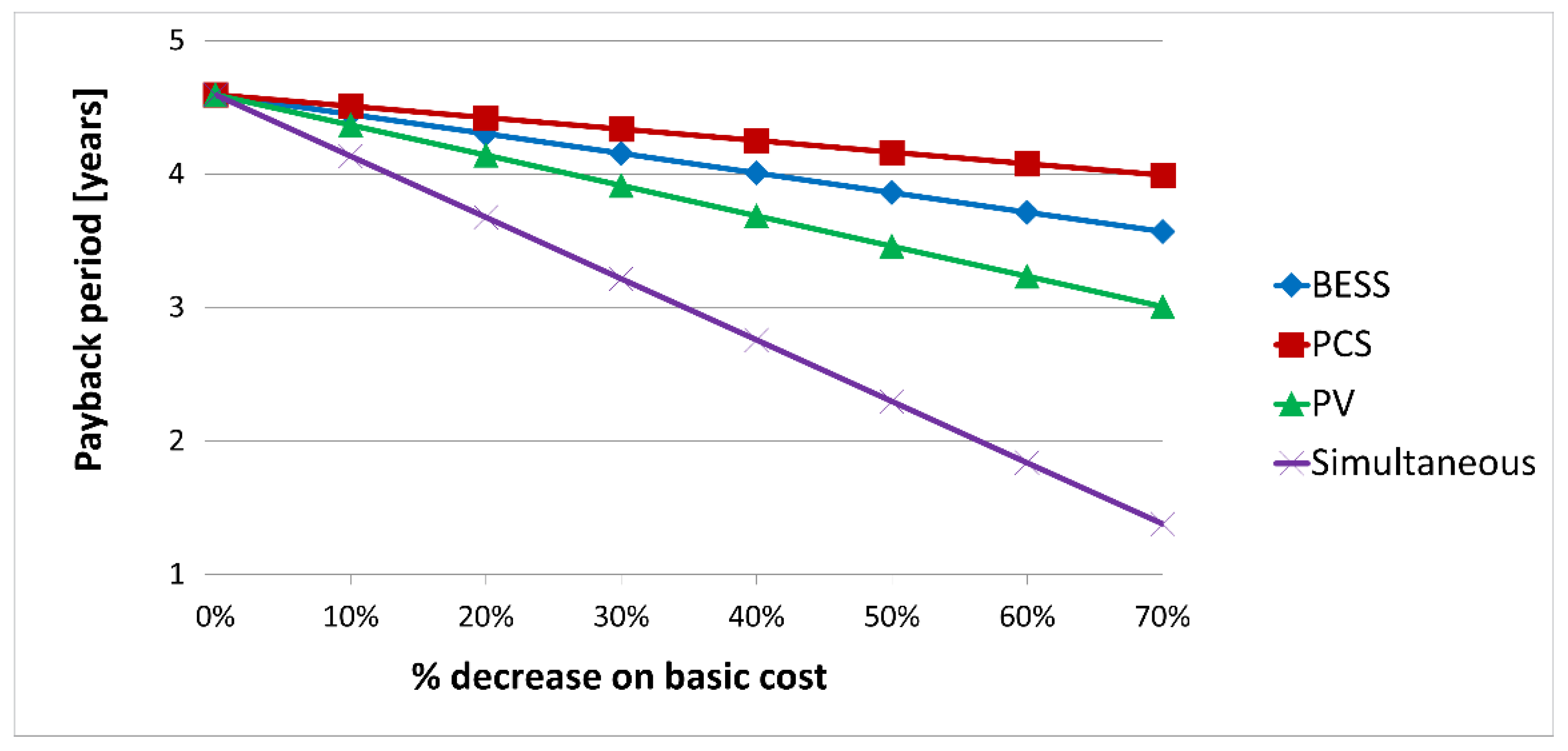
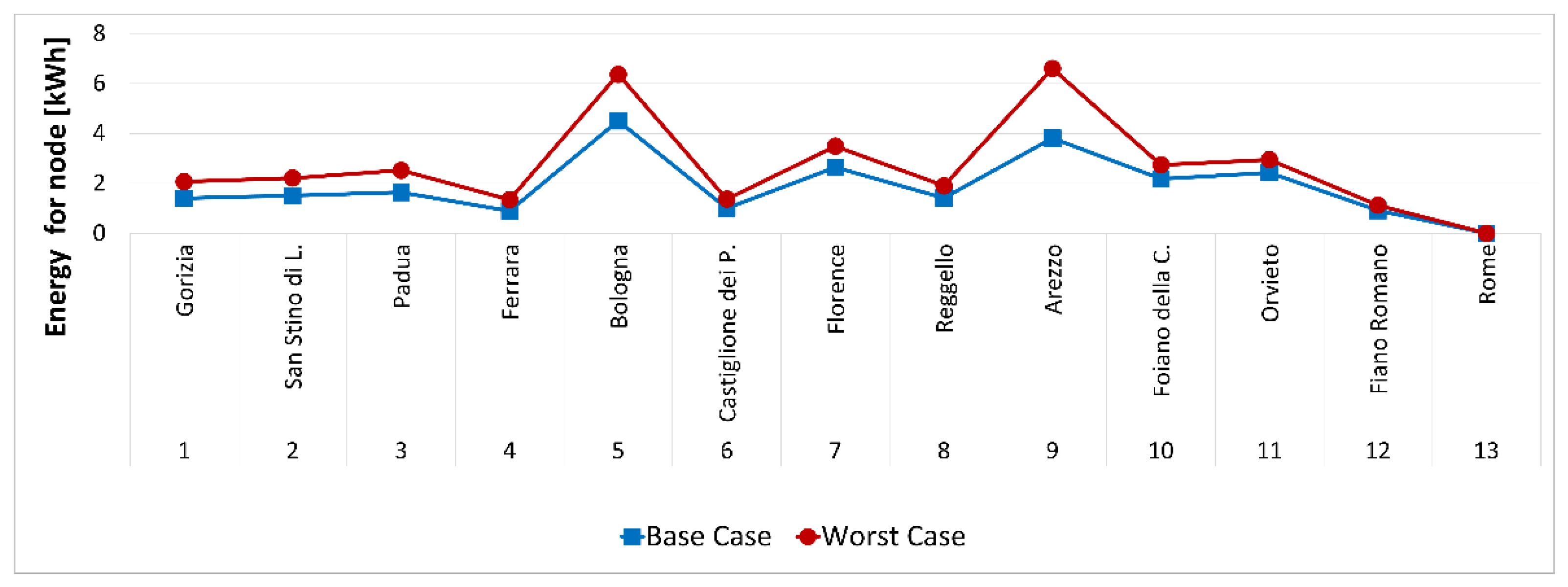
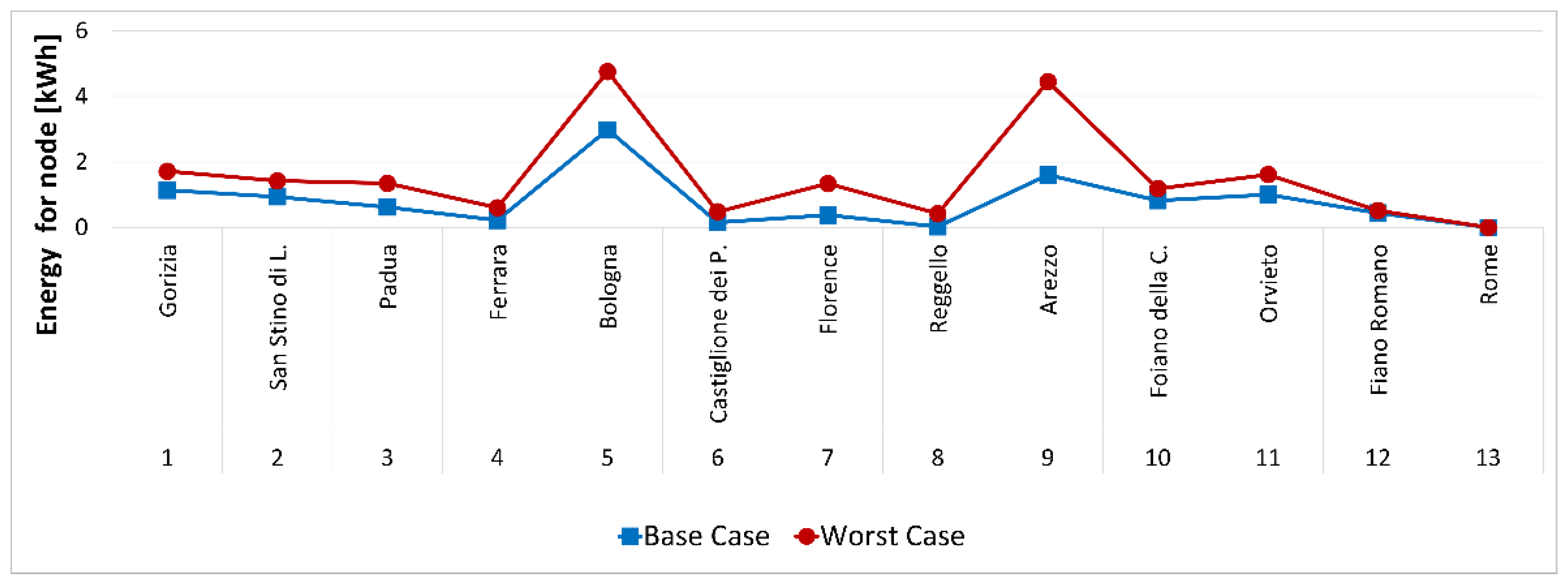
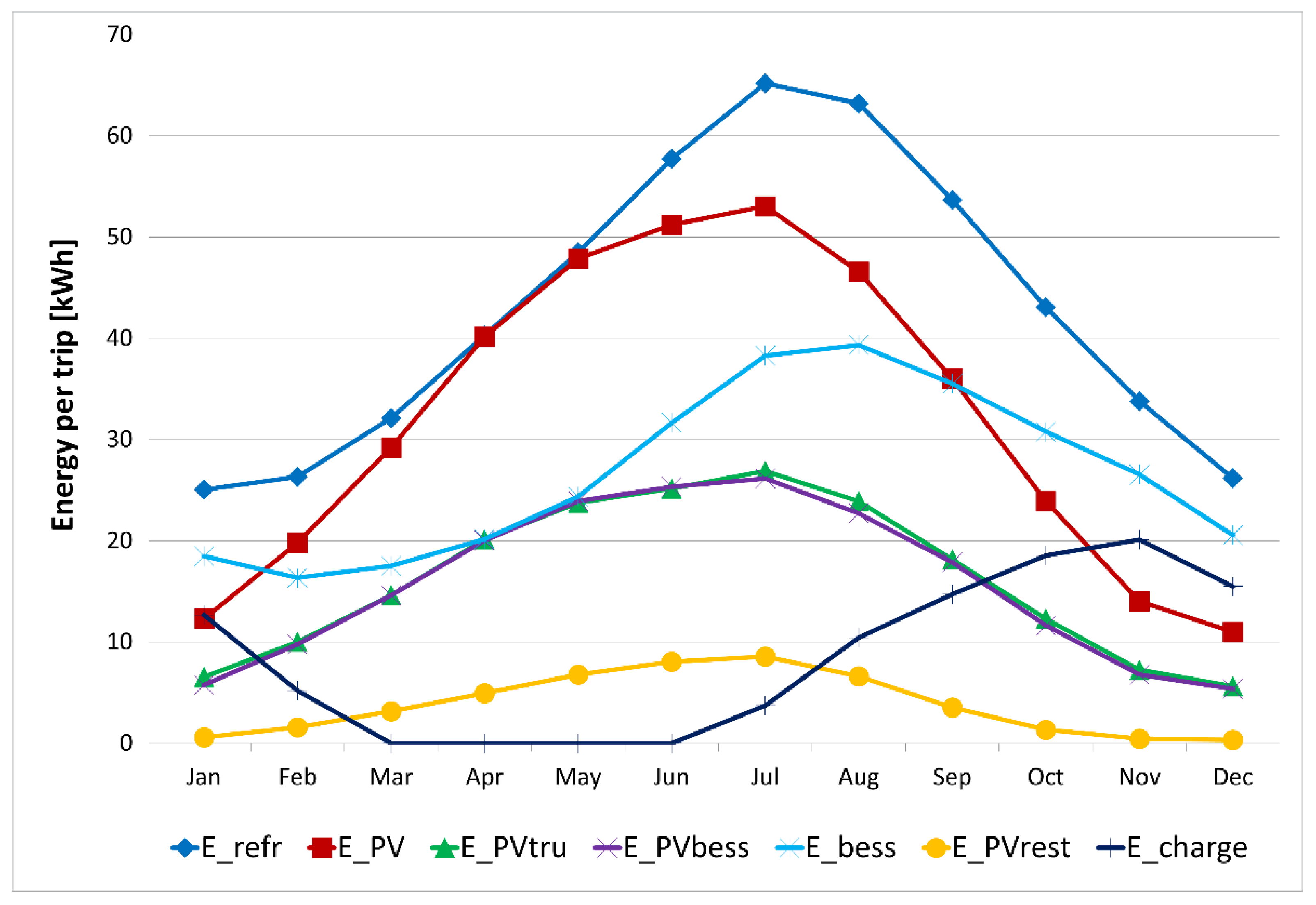
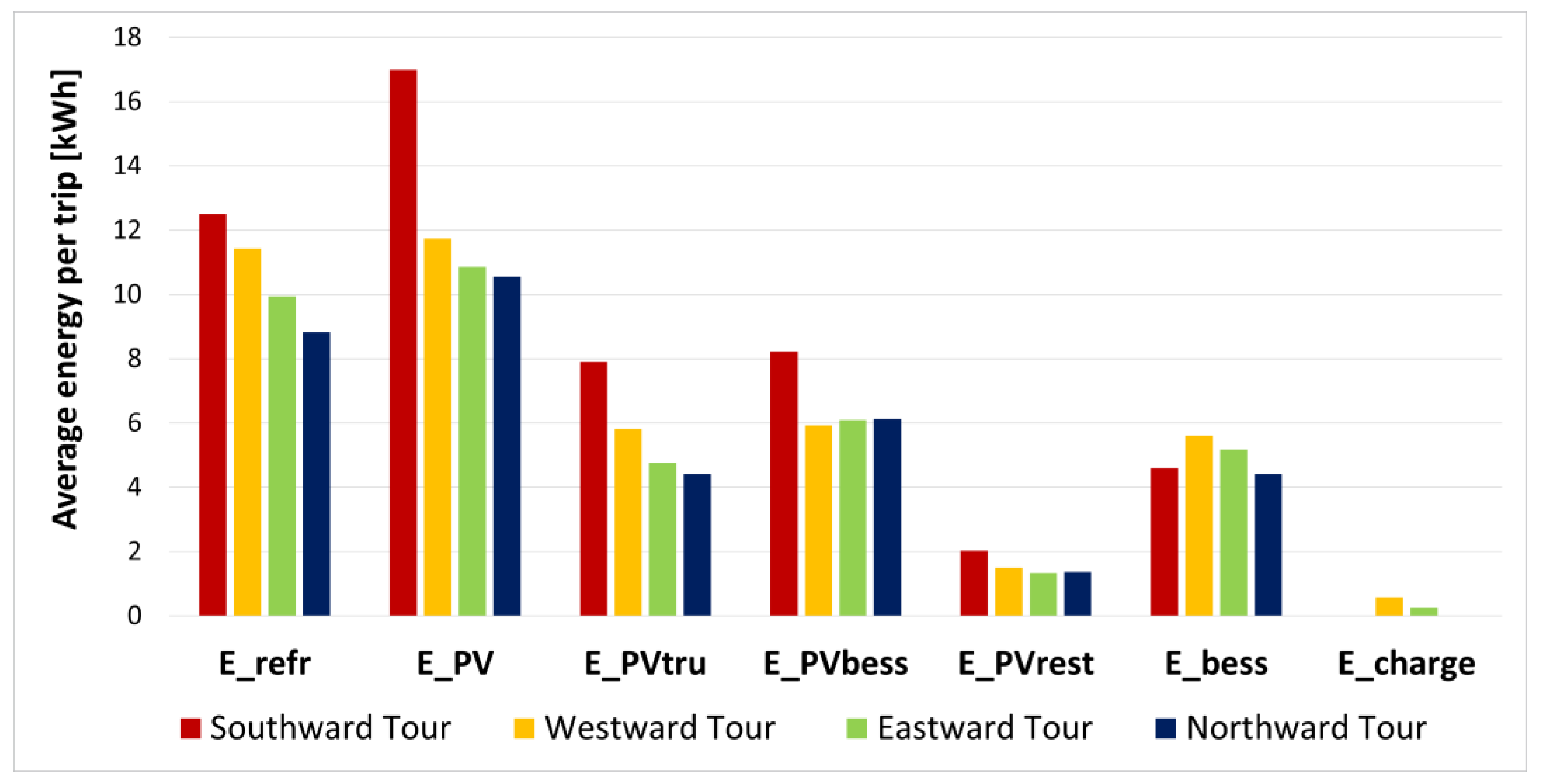


| Performance | Value |
|---|---|
| PV installed power on vehicle rooftop [kW] | 2.80 |
| BESS storage capacity [kWh] | 12.00 |
| PCS nominal power [kW] | 5.00 |
| Δ weight wrt diesel TRU [kg] | −306.2 |
| Delivery tour duration [h] | 32 |
| Average refrigeration demand per trip along the year [kWh] | 12.51 |
| Average transmission energy per trip along the year [kWh] | 10.02 |
| Average infiltration energy per trip along the year [kWh] | 2.48 |
| Average PV production per trip along the year [kWh] | 16.99 |
| Average demand covered by PV per trip along the year [kWh] | 7.91 |
| Average PV energy for battery charge during a trip [kWh] | 8.23 |
| Average PV energy generated during rest along the year [kWh] | 2.03 |
| Average energy supplied by the battery per trip along a year [kWh] | 4.60 |
| Average supply to the battery from the grid per trip [kWh] | 0.00 |
| Traction fuel savings for PV system weight wrt diesel engine [l/year] | 642.12 |
| Avoided emissions per trip [kgCO2eq] | 13.00 |
| Node | Arrival Time | Travel + Stop Time [h] | E_refr [kWh] | E_PV [kWh] | E_PVtru [kWh] | E_PVbess [kWh] | E_bess [kWh] | |||||
|---|---|---|---|---|---|---|---|---|---|---|---|---|
| Jul | Mar | Jul | Mar | Jul | Mar | Jul | Mar | Jul | Mar | |||
| 1 | 6:00 | 1.0 | 1.40 | 0.24 | 0.29 | 0.00 | 0.29 | 0.00 | 0.00 | 0.00 | 1.11 | 0.24 |
| 2 | 7:00 | 1.0 | 1.51 | 0.25 | 0.64 | 0.10 | 0.64 | 0.10 | 0.00 | 0.00 | 0.87 | 0.15 |
| 3 | 8:00 | 1.0 | 1.64 | 0.27 | 1.08 | 0.42 | 1.08 | 0.27 | 0.00 | 0.15 | 0.56 | 0.00 |
| 4 | 9:00 | 0.5 | 0.90 | 0.19 | 0.71 | 0.38 | 0.71 | 0.19 | 0.00 | 0.19 | 0.19 | 0.00 |
| 5 | 9:30 | 1.0 | 4.50 | 1.44 | 1.46 | 0.79 | 1.46 | 0.79 | 0.00 | 0.00 | 3.04 | 0.65 |
| 6 | 10:30 | 0.5 | 1.00 | 0.27 | 0.88 | 0.48 | 0.88 | 0.27 | 0.00 | 0.21 | 0.12 | 0.00 |
| 7 | 11:00 | 1.3 | 2.64 | 0.75 | 2.27 | 1.37 | 2.27 | 0.75 | 0.00 | 0.62 | 0.37 | 0.00 |
| 8 | 12:16 | 0.7 | 1.42 | 0.40 | 1.44 | 0.88 | 1.42 | 0.40 | 0.02 | 0.48 | 0.00 | 0.00 |
| 9 | 13:00 | 1.3 | 3.81 | 1.61 | 2.25 | 1.41 | 2.25 | 1.41 | 0.00 | 0.00 | 1.56 | 0.20 |
| 10 | 14:17 | 1.0 | 2.18 | 0.63 | 1.44 | 0.87 | 1.44 | 0.63 | 0.00 | 0.24 | 0.74 | 0.00 |
| 11 | 15:17 | 1.0 | 2.43 | 0.76 | 1.47 | 0.90 | 1.47 | 0.76 | 0.00 | 0.14 | 0.96 | 0.00 |
| 12 | 16:17 | 0.5 | 0.91 | 0.31 | 0.56 | 0.27 | 0.56 | 0.27 | 0.00 | 0.00 | 0.35 | 0.04 |
| 13 | 16:44 | 11.05 | 0.00 | 0.00 | 0.62 | 0.30 | 0.00 | 0.00 | 0.62 | 0.30 | 0.00 | 0.00 |
| 14 | 6:00 | 0.5 | 0.00 | 0.00 | 0.14 | 0.00 | 0.00 | 0.00 | 0.14 | 0.00 | 0.00 | 0.00 |
| 15 | 6:27 | 1.0 | 0.00 | 0.00 | 0.31 | 0.00 | 0.00 | 0.00 | 0.31 | 0.00 | 0.00 | 0.00 |
| 16 | 7:27 | 1.0 | 0.00 | 0.00 | 1.19 | 0.46 | 0.00 | 0.00 | 1.19 | 0.46 | 0.00 | 0.00 |
| 17 | 8:27 | 1.0 | 0.00 | 0.00 | 1.18 | 0.44 | 0.00 | 0.00 | 1.18 | 0.44 | 0.00 | 0.00 |
| 18 | 9:27 | 1.0 | 0.00 | 0.00 | 1.49 | 0.73 | 0.00 | 0.00 | 1.49 | 0.73 | 0.00 | 0.00 |
| 19 | 11:12 | 1.8 | 0.00 | 0.00 | 2.95 | 1.78 | 0.00 | 0.00 | 2.95 | 1.78 | 0.00 | 0.00 |
| 20 | 12:12 | 1.0 | 0.00 | 0.00 | 1.88 | 1.32 | 0.00 | 0.00 | 1.88 | 1.32 | 0.00 | 0.00 |
| 21 | 13:42 | 1.5 | 0.00 | 0.00 | 2.78 | 1.84 | 0.00 | 0.00 | 2.78 | 1.84 | 0.00 | 0.00 |
| 22 | 14:42 | 1.0 | 0.00 | 0.00 | 1.55 | 1.00 | 0.00 | 0.00 | 1.55 | 1.00 | 0.00 | 0.00 |
| Tour | 32.0 | 24.34 | 7.12 | 28.58 | 15.74 | 14.47 | 5.84 | 14.11 | 9.90 | 9.87 | 1.28 | |
| Cost | Value |
|---|---|
| PV panel investment cost [EUR] | 4642 |
| Li-ion battery investment cost [EUR] | 3000 |
| PCS investment cost [EUR] | 1761 |
| Charging BESS cost [EUR/year] | - |
| Maintenance [EUR/year] | 81 |
| Fuel savings for lower curb weight [EUR/year] | 997 |
| Objective function (annualized cost) [EUR/year] | 233 |
| Fuel avoided cost for diesel TRU [EUR/year] | 642 |
| Avoided maintenance for diesel TRU [EUR/year] | 509 |
| Simple payback [yr] | 4.59 |
| Node | 1 | 2 | 3 | 4 | 5 | 6 | 7 | 8 | 9 | 10 | 11 | 12 | 13 | Tot. |
|---|---|---|---|---|---|---|---|---|---|---|---|---|---|---|
| Gorizia | San Stino di L. | Padua | Ferrara | Bologna | Castiglione dei P. | Florence | Reggello | Arezzo | Foiano della C. | Orvieto | Fiano Romano | Rome | ||
| Base Case | 1.14 | 0.94 | 0.62 | 0.22 | 2.99 | 0.16 | 0.38 | 0.03 | 1.60 | 0.82 | 1.01 | 0.44 | 0.00 | 10.33 |
| Worst Case | 1.72 | 1.42 | 1.35 | 0.60 | 4.76 | 0.48 | 1.34 | 0.42 | 4.45 | 1.19 | 1.62 | 0.52 | 0.00 | 19.86 |
| Cumulative E_bess | 1.72 | 3.14 | 4.48 | 5.09 | 9.85 | 10.32 | 11.66 | 12.09 | 16.54 | 17.72 | 19.34 | 19.86 | 19.86 |
| Cost | Value |
|---|---|
| PV panel investment cost [EUR] | 4642 |
| Li-ion battery investment cost [EUR] | 3000 |
| PCS investment cost [EUR] | 1761 |
| Charging BESS cost [EUR/year] | 98 |
| Maintenance [EUR/year] | 81 |
| Fuel savings for lower curb weight [EUR/year] | −997 |
| Objective function (annualized cost) [EUR/year] | 330 |
| Fuel avoided cost for diesel TRU [EUR/year] | 1070 |
| Avoided maintenance for diesel TRU [EUR/year] | 969 |
| Simple payback [yr] | 3.31 |
Publisher’s Note: MDPI stays neutral with regard to jurisdictional claims in published maps and institutional affiliations. |
© 2021 by the authors. Licensee MDPI, Basel, Switzerland. This article is an open access article distributed under the terms and conditions of the Creative Commons Attribution (CC BY) license (https://creativecommons.org/licenses/by/4.0/).
Share and Cite
Meneghetti, A.; Pagnin, C.; Simeoni, P. Decarbonizing the Cold Chain: Long-Haul Refrigerated Deliveries with On-Board Photovoltaic Energy Integration. Sustainability 2021, 13, 8506. https://doi.org/10.3390/su13158506
Meneghetti A, Pagnin C, Simeoni P. Decarbonizing the Cold Chain: Long-Haul Refrigerated Deliveries with On-Board Photovoltaic Energy Integration. Sustainability. 2021; 13(15):8506. https://doi.org/10.3390/su13158506
Chicago/Turabian StyleMeneghetti, Antonella, Chiara Pagnin, and Patrizia Simeoni. 2021. "Decarbonizing the Cold Chain: Long-Haul Refrigerated Deliveries with On-Board Photovoltaic Energy Integration" Sustainability 13, no. 15: 8506. https://doi.org/10.3390/su13158506






